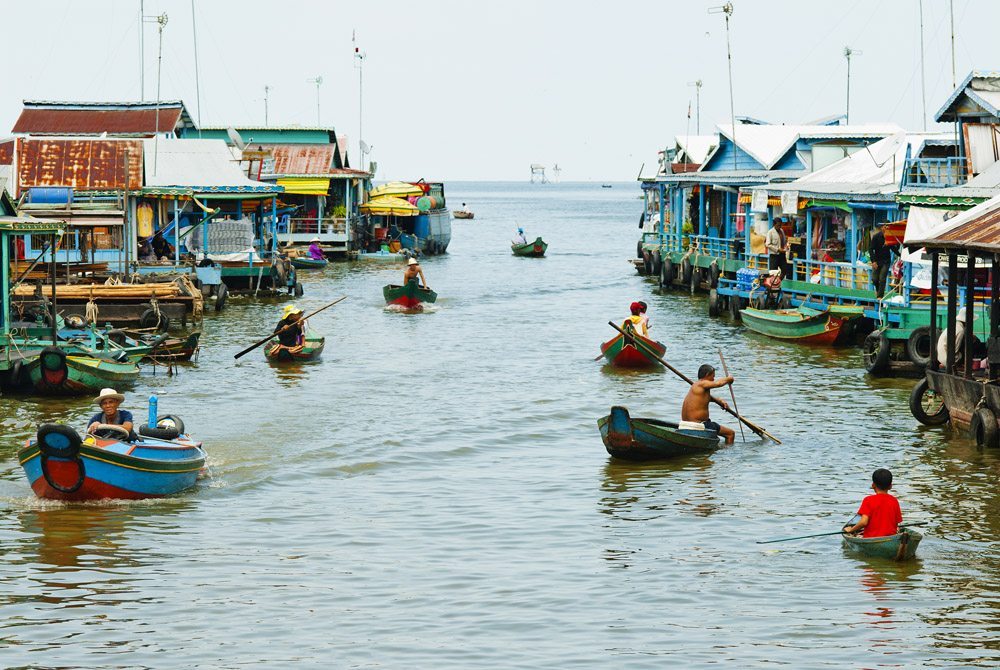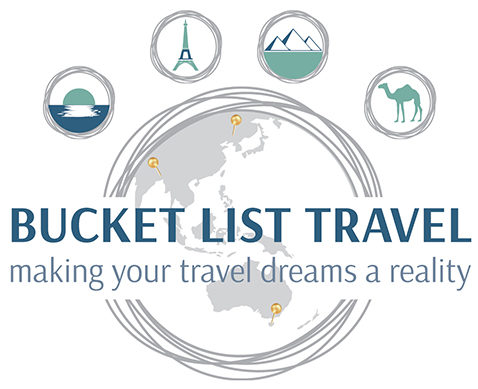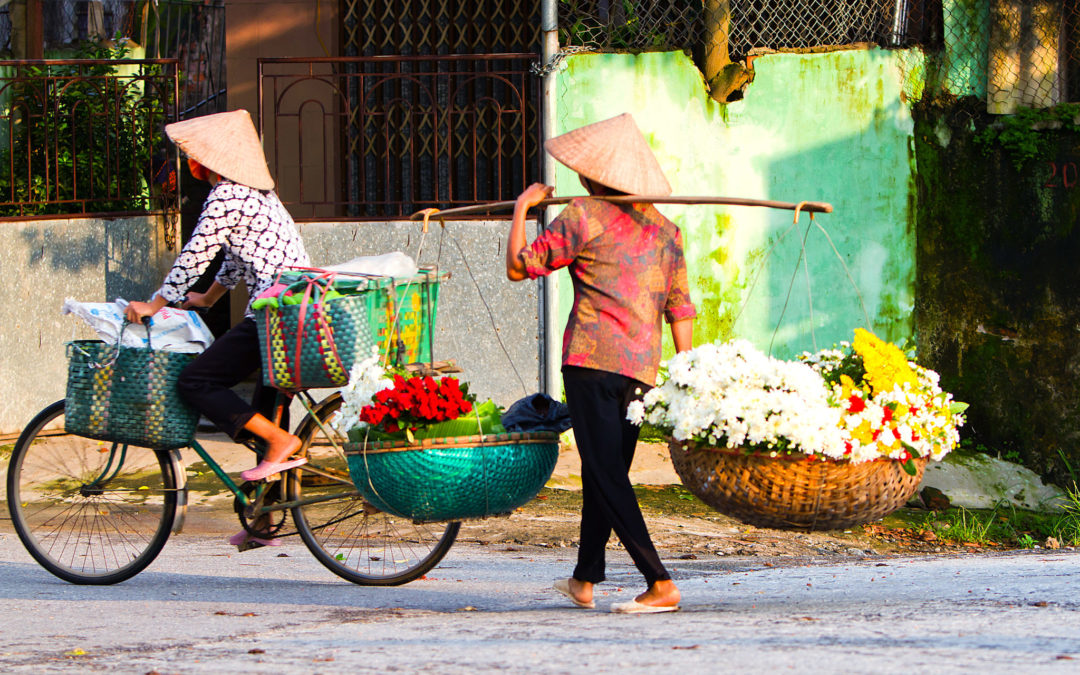Nature, culture and history – Vietnam has it all
Discover the beauty of places such as Ha Long Bay, an idyllic waterway of forest-drenched outcrops. Ho Chi Minh City shows Vietnam’s urban side, with attractions like the War Remnants Museum and French colonial buildings.
We have chosen Vietnam as a featured trip as nearly everyone we talk to has either recently been to Vietnam or it’s on their bucket list to go to in the next couple of years. It’s been on my bucket list for quite a few years, so I’m excited to say I’m ticking this one off my list and have booked to go with a group of friends for 3 weeks in July.
Fresh exotic cuisine, the warmth and openness of the Vietnamese people, French colonial history, limestone islands, and beautiful beaches make Vietnam a delight to visit! Have clothes tailored in the small colonial town of Hoi An, relax at the exclusive Six Senses Resorts in Nha Trang and Con Dao, cruise Halong Bay on a traditional junk, or the Mekong on a Bassac Boat. Visit the mountain retreat of Sapa to visit traditional hilltribe villages and share home cooked meals with the locals. Visitors to Vietnam are overwhelmed by the sublime beauty of the country’s natural setting and traditional charm.

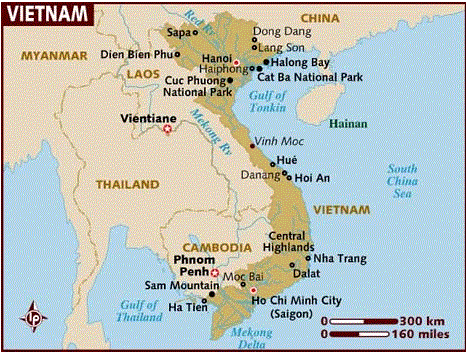
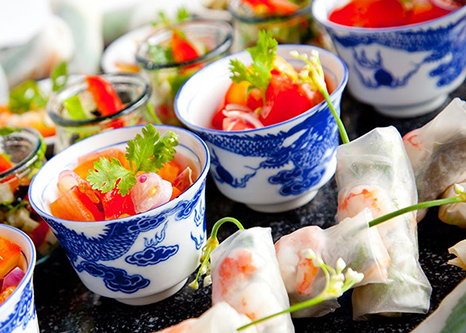
Beaches, mountains, culture: Vietnam has it all
Population: 91 million people + 60 million mopeds
Capital City: Hanoi
People: 80% Ethnic Vietnamese, 53 minority groups including Hmong, Tay, Cham, Montagnards, Khmer, and Chinese
Language: Vietnamese
Religion: Predominantly Buddhist, with Confucianism, Taoism , Christianity& other minorities
Currency: Vietnamese Dong
Time: GMT plus 7 hours (5 hours behind NZ standard time)
Vietnamese cuisine is fresh, fragrant and feisty; highly regarded as one of the world’s best. Few realize the delicious regional variations that are found in the South, Central, and Northern styles.
Our Choices
Sapa
Sapa is a town in Lao Cai Province in Northwest Vietnam close to the Chinese border. It is located about 350km Northwest of Hanoi. Here is where one will find the Hoang Lien Son range of mountains, which includes Fan Si Pan—the country’s highest peak.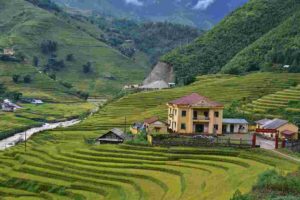
This quiet Vietnamese town is home to a population which consists mostly of minority groups. There are five main ethnic groups in Sapa: the Hmong, Dao, Tay, Giay and Xa Pho. It is said that Sapa was first occupied by the first four groups, since the Vietnamese from the lowlands (better known as the Kinh) did not colonise the highest valleys. It was only when the French arrived in Tonkin in the 19th century that Sapa was acknowledged and included on the national map. The site where Sapa would be became a key location for the French military as well as missionaries.
It was also only in 1993 that Sapa became accessible to many, as this was the year its doors were opened to tourists. Sapa is known for the traditional festivals of its various ethnic hill-tribe groups, including the Hmong’s Gau Tao Festival (Jan), with singing contests and traditional costumes; and the Tay people’s Long Tong Festival (Feb), with ceremonies, games and folk dancing.
When to visit
Most visitors come Mar–May & Sep–Nov, when days are warm and nights are cool. There’s a rainy season May–Sep. Winter (Dec–Feb) is cold with fog and occasional snow.
Hanoi
Hanoi’s trademark is its dozens of parks and lakes. Considered one of the most beguiling cities in South-East Hanoi’s beauty also comes in the form of broad tree-lined boulevards, belle epoque villas and beautiful temples reflecting a blend of Indochinese and French-colonial influences.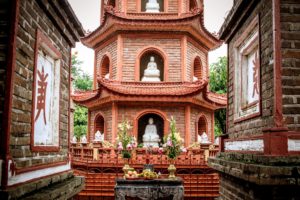
This lovely city welcomes tourists with open arms, offering an extensive range of accommodation options, attractions, major events, sightseeing, cultural experiences and entertainment options. This, combined with old-fashioned charm and mouth-watering cuisine, ensures Hanoi is a place to win your heart.
A great place to start exploring the city is Hoan Kiem Lake in the centre of the city – a pretty lake steeped in Arturian-style legend. Then wander the maze of narrow streets in the Old Quarter, offering everything from silk clothing and ceramics to motorbike seats. Ride a cyclo through the area to gain a great insight into the Hanoian way of life. Important holidays include Tết, or Vietnamese New Year (Jan/Feb, dates vary); the Full Moon/Mid-Autumn Festival (Aug/Sep, dates vary); and National Day (Sep 2), celebrated with fireworks and boat races on the lake.
Insiders’ Tips
- Visit Hoan Kiem Lake: This pretty and mystical lake is known as ‘Lake of the Restored Sword’.
- Visit Phung Hung Markets: Learn about Vietnamese cuisine, as well as the local ingredients and spices.
- See a Water Puppet Show: Traditional legends and historical tales are told using puppets over water
- Take a Trip to Halong Bay: Cruise around the turquoise waters and limestone cliffs in a traditional junk.
- Stroll Around Hoan Kiem Lake: Also known as Sword Lake, it lies at the heart of Hanoi
When to visit
Most visitors come in Nov–Dec & Mar–Apr, when the weather is generally warm and clear. The tropical climate is humid year-round, with a hot and rainy monsoon season May–Sep.
Ho Chi Minh City (Saigon)
As one might expect from Vietnam’s largest city, Ho Chi Minh City (formerly known as Saigon) is a fast-moving, chaotic whirl of sights, sounds and activity. Once you get used to the city’s pace, you’ll quickly enjoy the ride as you take a journey into the heart and soul of Vietnam, its people, history, culture and ambitious future.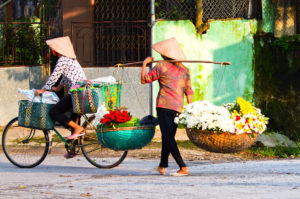
Historically significant must-sees include the Museum of Vietnamese History, the War Remnants Museum and the Reunification Hall (formerly a presidential palace and the site where, in 1975, tanks crashed through the gates of the Prime Minister’s palace). Highly recommended is a day-trip to the Cu Chi Tunnels, where you can crawl through a section of an immense network of underground tunnels that were the location of several military campaigns during the Vietnam (American) War.
Don’t miss the elaborate woodcarvings of gilded characters and local deities at the Emperor of Jade Pagoda. For a taste of the present, stroll along Saigon River, take a boat trip on the Mekong Delta, spend up big at Saigon Square and visit the friendly Ben Thanh Market or the bustling markets of Cholon, located in the ancient Chinese quarter. Many of Ho Chi Minh’s landmarks from the French-colonial days remain, giving the otherwise-sprawling metropolis some architectural charm and character. Key events and holidays include Tết, or Vietnamese New Year (Jan/Feb, dates vary), for which many businesses close, and the Mid-Autumn/Full Moon Festival (Sep/Oct, dates vary), celebrated with mooncakes and lanterns.
Insiders’ Tips
- The War Remnants Museum: Once known as the Museum of American War Crimes, learn about the war through a range of fascinating exhibits.
- Visit the Notre Dame Cathedral: This French-built cathedral occupies Paris Square in the heart of Saigon.
- Crawl the Cu Cji Tunnels: This incredible network of underground tunnels was used during the Vietnam War.
- Shop on Dong Khoi Street: Enjoy an unforgettable gallery-and boutique-lined shopper’s paradise.
- Experience Saigon Nightlife: Plenty of restaurants, bars and bia hoi vendors are open late in District 1.
When to visit
Most visitors come Dec–Apr, when the tropical weather is warm and dry. The rainy season is May–Nov.
Halong Bay
Halong Bay is a beautiful natural wonder in northern Vietnam near the Chinese border. The Bay is dotted with 1,600 limestone islands and islets and covers an area of over 1,500 sqkm. This extraordinary area was declared a UNESCO World Heritage Site in 1994. For many tourists, this place is like something right out of a movie. The fact is that Halong Bay features a wide range of biodiversity, while the surrealistic scenery has indeed featured in endless movies.
Key events include Tết, or Vietnamese New Year (Jan/Feb, dates vary); and the Fishing Village Festival (Cát Bà Island, Apr 1), including dragon-boat racing and performances of traditional dance and music.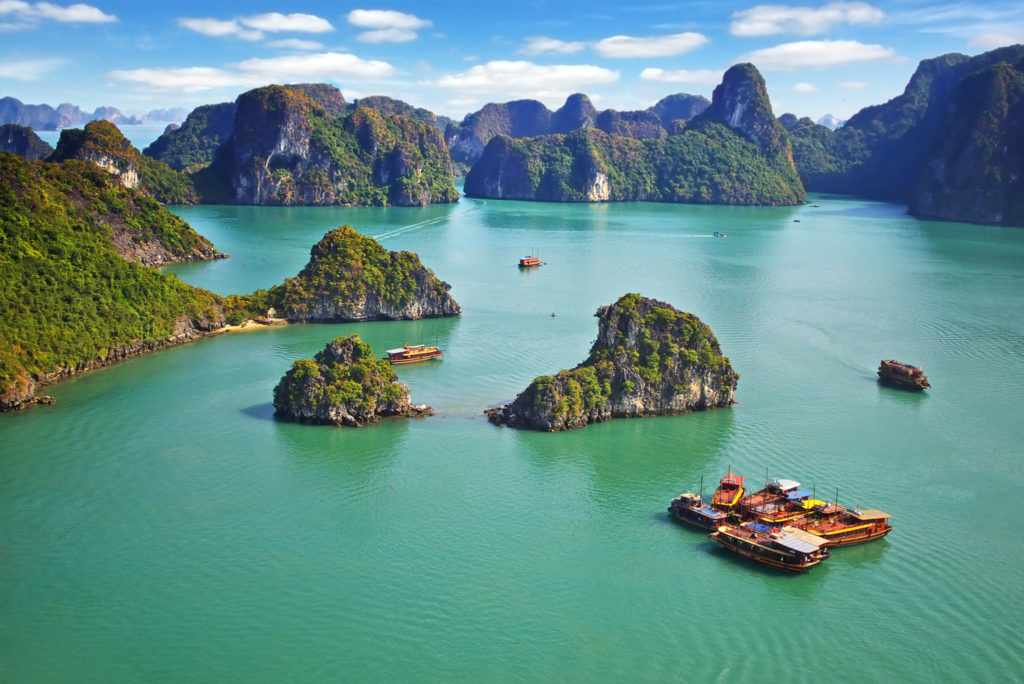
When to visit
The best time to visit is in spring and autumn, to be more specific, in March, April, September and October. In these months, the weather is often delightful, the temperature is mild, the sky is clear and bright, and the activity level is high.
Hoi An
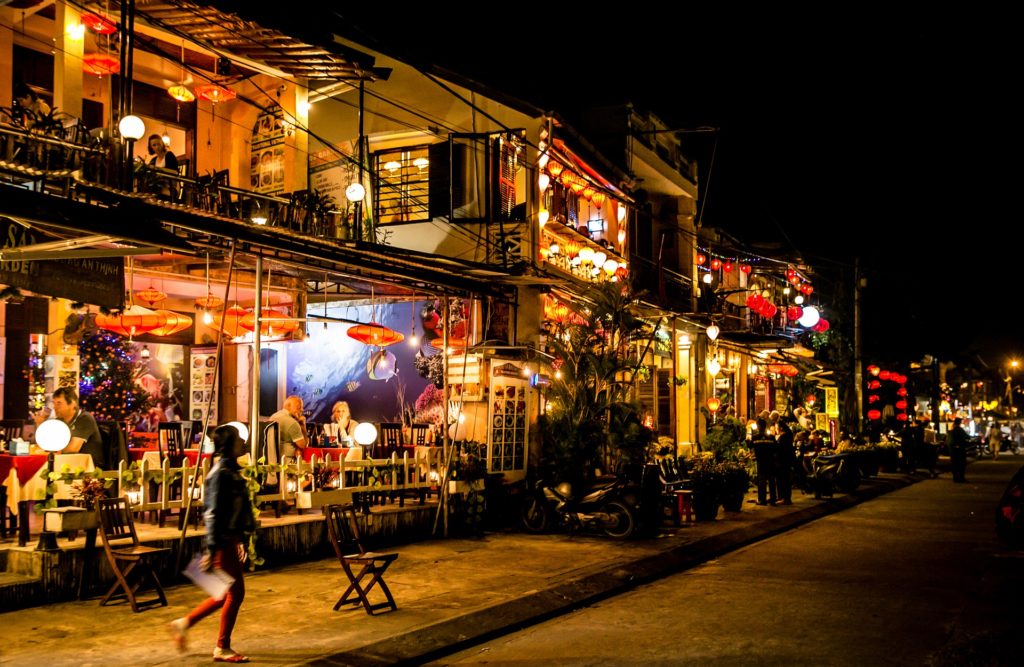 This town is an exceptionally well-preserved example of a Southeast Asian trading port dating from the 15th to the 19th century. Its buildings and its street plan reflect the influences, both indigenous and foreign, that have combined to produce this unique heritage site.
This town is an exceptionally well-preserved example of a Southeast Asian trading port dating from the 15th to the 19th century. Its buildings and its street plan reflect the influences, both indigenous and foreign, that have combined to produce this unique heritage site.
Hoi An has no airport, and no train station either. The only way to get there is by road. You can hire a taxi from the neighbouring city of Da Nang, which does have an airport with daily flights from Hanoi, Ho Chi Minh City and other large Vietnamese cities. There’s also a train station in Da Nang, and bus services are plentiful.
Along with the monthly full moon celebrations, key cultural events include Tết, or Vietnamese New Year (Jan/Feb, dates vary), as well as the Nguyen Tieu festival (dates vary), celebrated 15 days later and focused on temple rituals. The energetic Mid-Autumn Festival (fall, dates vary) is known for moon cakes, traditionally eaten at this time, and parades featuring lion dances.
When to visit
Most travelers arrive Dec–Apr & Jul–Aug. The tropical climate is hot year-round, and during rainy season (Sep–Jan), monsoons are possible.
Nha Trang
Nha Trang, also known as the Riviera of the South China Sea, offers a six-kilometre stretch of beautiful coastline with white sandy beaches, clear waters with an abundance of marine life and thriving reefs, verdant mountain ranges at each end, as well as 19 untouched islets that are just a short boat ride away.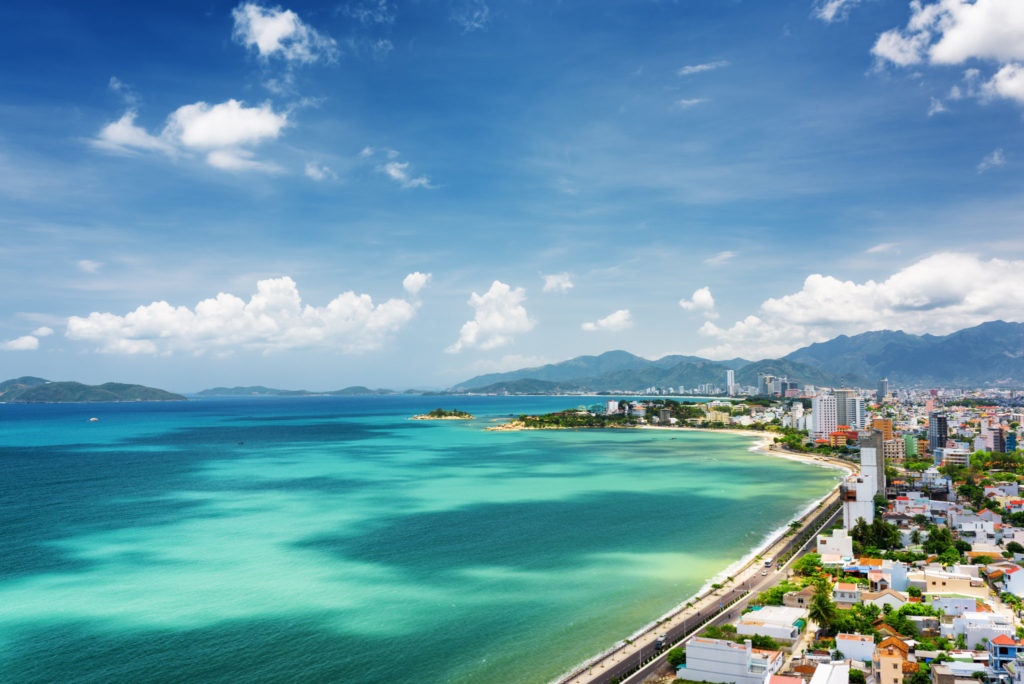
Offering a myriad of sightseeing and recreational activities, the coastal town itself is steeped with breath-taking structures that date back to the Champa Kingdom, Buddhist temples, and gothic-style Catholic churches, as well as natural hot springs, salt fields, and unique waterfalls. Catering to any budget level and preference, Nha Trang restaurants serve up fresh seafood and Vietnamese cuisine while lively bars and pubs along the pristine beach are favourite hangouts for tourists to watch the sun sets over the East Sea.
Key events and holidays include Tết, or Vietnamese New Year (Jan/Feb, dates vary); the Po Nagar/Thap Ba festival (Mar/Apr, dates vary) at the Po Nagar Cham temples, featuring ceremonies and traditional song and dance; and the Che Ngo Festival (Nov), with longboat races.
When to visit
The peak travel periods are Feb & Jul–Aug. The tropical climate is warm year-round, with a rainy monsoon season from Oct–Dec.
The Mekong River
The longest river in Southeast Asia and the 12th longest on earth, the Mekong River journeys over 2700 miles from the Tibetan Plateau to the southeast, through Laos and Thailand to the equatorial flood plains of Cambodia and Vietnam, then finally flows into the South China Sea.
Two thousand years of human history flow along the Mekong River. It is said that the rise and fall of the great Khmer civilization, responsible for the building of Angkor Wat, was inextricably linked to the Mekong’s shifting tides.
Today, around 60 million people live, work and play on the Mekong. Fish from the river comprise Cambodia’s single largest source of protein and it is rightly called the rice bowl of Vietnam, as it is on the fertile lands of the Mekong River Delta that the Vietnamese people grow half their nation’s agricultural product.
The Mekong River is also a hub for Vietnamese culture and a major transportation route for villagers living in the Delta. From floating markets selling fish, coconut candy, tropical fruit, vegetables and flowers to bee farms that line the river, the Mekong throbs from before sunrise to after dark with vital economic activity.
